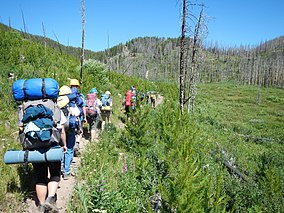Scapegoat Wilderness
| Scapegoat Wilderness | |
|---|---|
 | |
| Location | Lewis and Clark / Powell counties, Montana, United States |
| Nearest city | Missoula, MT |
| Coordinates | 47°07′0″N 112°44′0″W / 47.11667°N 112.73333°W |
| Area | 239,936 acres (971 km2) |
| Established | 1972[1] |
| Governing body | U.S. Forest Service |
The Scapegoat Wilderness consists of 239,936 acres (971 km2) spread across three different National Forests in the U.S. state of Montana. Created by an act of Congress in 1972, the wilderness is located in Lewis and Clark, Helena and Lolo National Forests. The Scapegoat Wilderness is a part of the 1.5 million acre (6,070 km2) Bob Marshall Wilderness Complex as it shares a boundary with the Bob Marshall Wilderness, which in turn is connected to the Great Bear Wilderness further north.
U.S. Wilderness Areas do not allow motorized or mechanized vehicles, including bicycles. Although camping and fishing are allowed with proper permit, no roads or buildings are constructed and there is also no logging or mining, in compliance with the 1964 Wilderness Act. Wilderness areas within National Forests and Bureau of Land Management areas also allow hunting in season.
The Continental Divide creates the western boundary of the wilderness. Rising as much as 1,500 feet (460 m) in places, the Chinese Wall, a portion of the expansive Rocky Mountain Front, stretches a distance of 20 miles (32 km) through the wilderness. With elevations between 5,000 to 9,000 feet (1,500 to 2,700 m) or more above sea level, the wilderness lies just west of the Great Plains, and from the higher mountaintops the views to the east extend for 70 miles (110 km) . The highest peak in the wilderness is Red Mountain 9,414 feet (2,869 m).
With most of the wilderness heavily forested in conifers, the primary tree species found include Engelmann spruce, ponderosa pine, lodgepole pine and Douglas fir. The wolf and grizzly call the wilderness home as do black bears, moose, elk, mountain goats, bighorn sheep and mule deer. Rare sightings of wolverine and mountain lions are possible along with bald eagles, peregrine falcons, trumpeter swans and pelicans. Eight species of fish inhabit the lakes and streams with rainbow trout and northern pike being the most common game fish. Fourteen lakes are located in the wilderness as well as the headwaters of the Blackfoot River.
Considered an excellent backpacking region, there are over 150 miles (240 km) of trails which generally follow the numerous streams and rivers. Pack trips on horseback are also a popular mode of travel.
Located about 75 miles (120 km) northeast of Missoula, Montana, the best access is from forest service roads off U.S. Highway 287 and Montana highways 200 and 83.
Bugle Mountain (also known as "Bugle Peak"), located in the Scapegoat Wilderness, was the setting of a forest fire in the fictional 1952 motion picture Red Skies of Montana. The film, based in part on the tragic 1949 Mann Gulch fire, was filmed in Montana.
See also
References
- ^ Bob Marshall Country. Globe Pequot Press. 2001. p. 193. ISBN 978-1-56044-798-6.
External links
- "Scapegoat Wilderness". The National Wilderness Preservation System. Wilderness.net. Retrieved 2006-08-16.
{{cite web}}: Cite has empty unknown parameter:|coauthors=(help) - "USGS Stonewall Mountain (MT) Topo Map Quad". TopoQuest. Retrieved 2008-07-04.
{{cite web}}: Cite has empty unknown parameter:|coauthors=(help) - "Wilderness Legislation: The Wilderness Act of 1964". The National Wilderness Preservation System. Wilderness.net. Retrieved 2006-08-16.
{{cite web}}: Cite has empty unknown parameter:|coauthors=(help)

